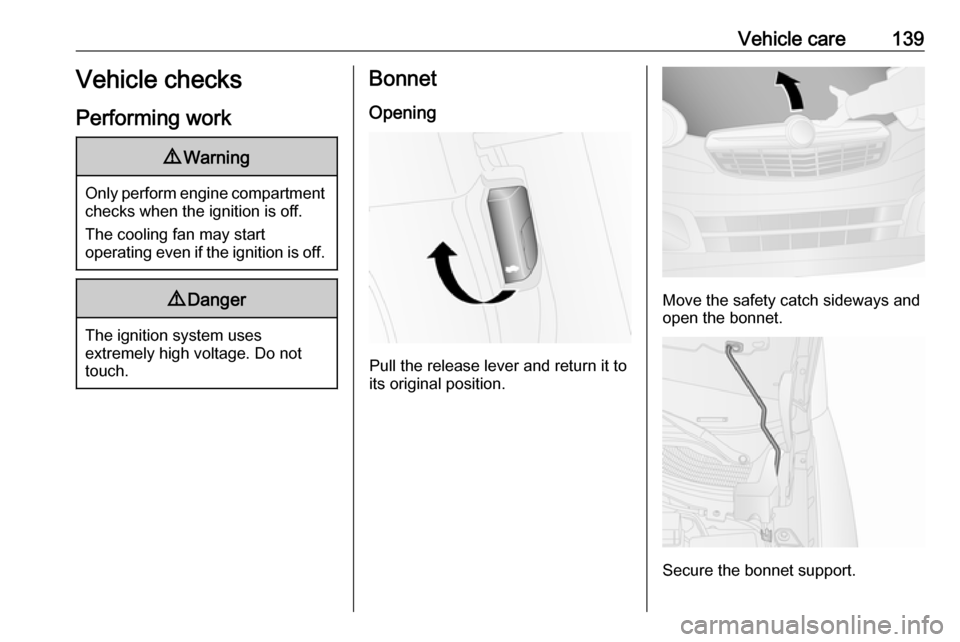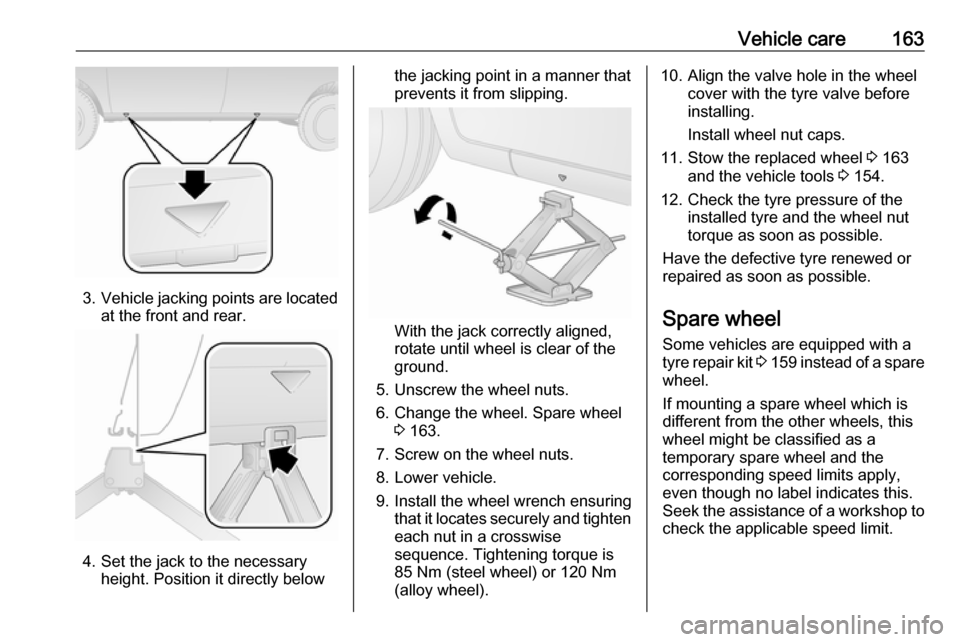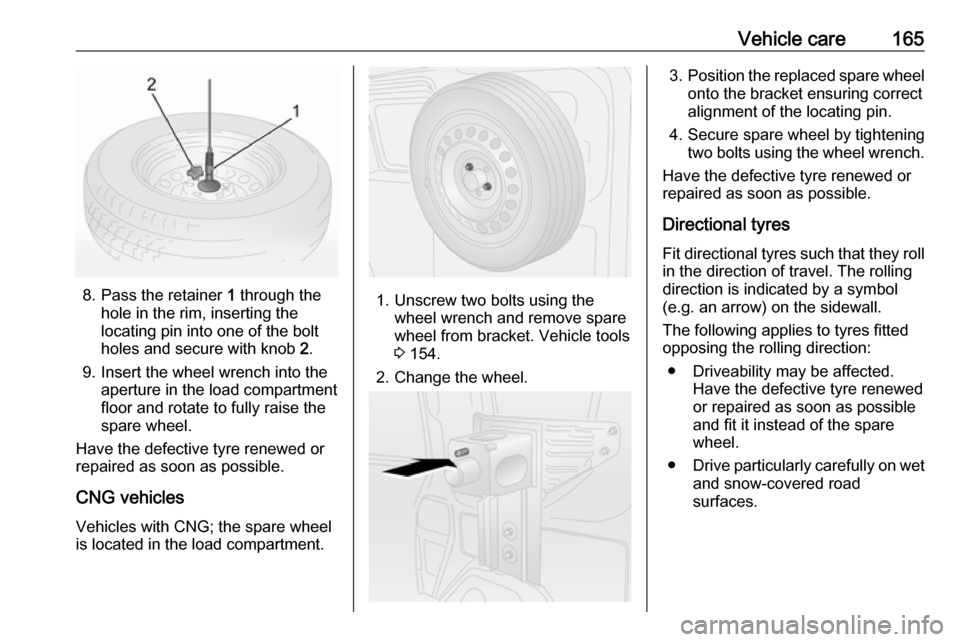ECU OPEL COMBO 2017 Manual user
[x] Cancel search | Manufacturer: OPEL, Model Year: 2017, Model line: COMBO, Model: OPEL COMBO 2017Pages: 195, PDF Size: 4.71 MB
Page 69 of 195

Storage67luggage (7 kg) and all fluids (fuel
tank 90% full).
Optional equipment and
accessories increase the kerb
weight.
● Driving with a roof load increases
the sensitivity of the vehicle to
cross-winds and has a
detrimental effect on vehicle
handling due to the vehicle's
higher centre of gravity.
Distribute the load evenly and secure it properly with retaining
straps. Adjust the tyre pressure
and vehicle speed according to
the load conditions. Check and
retighten the straps frequently.
Do not drive faster than
120 km/h.
The permissible roof load (which includes the weight of the roof
rack) is 100 kg. The roof load is
the combined weight of the roof
rack and the load.
Page 141 of 195

Vehicle care139Vehicle checks
Performing work9 Warning
Only perform engine compartment
checks when the ignition is off.
The cooling fan may start
operating even if the ignition is off.
9 Danger
The ignition system uses
extremely high voltage. Do not
touch.
Bonnet
Opening
Pull the release lever and return it to
its original position.
Move the safety catch sideways and
open the bonnet.
Secure the bonnet support.
Page 164 of 195

162Vehicle care2. Turn the canister anticlockwise tolift it out.
3. Insert the new canister and turn it clockwise.
4. Connect the compressor air hose to the canister and fit the flexible
filler tube into its allocated space.
Wheel changing
Some vehicles are equipped with a
tyre repair kit instead of a spare wheel 3 159.
Make the following preparations and
observe the following information:
● Park the vehicle on a level, firm and non-skid surface. The front
wheels must be in the straight-
ahead position.
● Apply the parking brake and engage first or reverse gear.
● Remove the spare wheel 3 163.
● Never change more than one wheel at once.
● Use the jack only to change wheels in case of puncture, not
for seasonal winter or summer
tyre change.● The jack is maintenance-free.
● If the ground on which the vehicle
is standing is soft, a solid board
(max. 1 cm thick) should be
placed under the jack.
● No people or animals may be in the vehicle when it is jacked-up.
● Never crawl under a jacked-up vehicle.
● Do not start the vehicle when it is
raised on the jack.
● Clean wheel nuts and thread with
a clean cloth before mounting the
wheel.9 Warning
Do not grease wheel bolt, wheel
nut and wheel nut cone.
1. Disengage wheel nut caps with a screwdriver and remove. Pull off
the wheel cover using a suitable
tool.
2. Attach wheel wrench securely and loosen each wheel nut by halfa turn.
Page 165 of 195

Vehicle care163
3.Vehicle jacking points are located
at the front and rear.
4. Set the jack to the necessary height. Position it directly below
the jacking point in a manner that
prevents it from slipping.
With the jack correctly aligned,
rotate until wheel is clear of the
ground.
5. Unscrew the wheel nuts. 6. Change the wheel. Spare wheel 3 163.
7. Screw on the wheel nuts.
8. Lower vehicle.
9. Install the wheel wrench ensuring that it locates securely and tighten
each nut in a crosswise
sequence. Tightening torque is
85 Nm (steel wheel) or 120 Nm
(alloy wheel).
10. Align the valve hole in the wheel cover with the tyre valve before
installing.
Install wheel nut caps.
11. Stow the replaced wheel 3 163
and the vehicle tools 3 154.
12. Check the tyre pressure of the installed tyre and the wheel nut
torque as soon as possible.
Have the defective tyre renewed or
repaired as soon as possible.
Spare wheel Some vehicles are equipped with atyre repair kit 3 159 instead of a spare
wheel.
If mounting a spare wheel which is
different from the other wheels, this
wheel might be classified as a
temporary spare wheel and the
corresponding speed limits apply,
even though no label indicates this.
Seek the assistance of a workshop to
check the applicable speed limit.
Page 167 of 195

Vehicle care165
8. Pass the retainer 1 through the
hole in the rim, inserting the
locating pin into one of the bolt
holes and secure with knob 2.
9. Insert the wheel wrench into the aperture in the load compartment
floor and rotate to fully raise the
spare wheel.
Have the defective tyre renewed or repaired as soon as possible.
CNG vehicles
Vehicles with CNG; the spare wheel
is located in the load compartment.1. Unscrew two bolts using the wheel wrench and remove spare
wheel from bracket. Vehicle tools
3 154.
2. Change the wheel.
3. Position the replaced spare wheel
onto the bracket ensuring correct
alignment of the locating pin.
4. Secure spare wheel by tightening two bolts using the wheel wrench.
Have the defective tyre renewed or
repaired as soon as possible.
Directional tyres Fit directional tyres such that they rollin the direction of travel. The rolling
direction is indicated by a symbol
(e.g. an arrow) on the sidewall.
The following applies to tyres fitted
opposing the rolling direction:
● Driveability may be affected. Have the defective tyre renewed
or repaired as soon as possible
and fit it instead of the spare
wheel.
● Drive particularly carefully on wet
and snow-covered road
surfaces.
Page 189 of 195

Customer information187● vehicle reactions in particulardriving situations (e.g. inflation ofan airbag, activation of the
stability regulation system)
● environmental conditions (e.g. temperature)
This data is exclusively technical and
helps identifying and correcting errors
as well as optimizing vehicle
functions.
Motion profiles indicating travelled
routes cannot be created with this
data.
If services are used (e.g. repair
works, service processes, warranty cases, quality assurance),
employees of the service network
(manufacturer included) are able to
read out this technical information
from the event and error data storage
modules applying special diagnostic
devices. If required, you will receive
further information at these
workshops. After an error has been
corrected, the data is deleted from the error storage module or it is
constantly overwritten.When using the vehicle, situations
may occur in which technical data
related to other information (accident
report, damages on the vehicle,
witness statements etc.) may be
associated with a specific person -
possibly, with the assistance of an
expert.
Additional functions contractually
agreed upon with the client (e.g.
vehicle location in emergency cases)
allow the transmission of particular vehicle data from the vehicle.
Radio Frequency
Identification (RFID)
RFID technology is used in some
vehicles for functions such as tyre
pressure monitoring and ignition
system security. It is also used in
connection with conveniences such
as radio remote controls for door
locking/unlocking and starting, and in-
vehicle transmitters for garage door
openers. RFID technology in Opel
vehicles does not use or record
personal information or link with any
other Opel system containing
personal information.
Page 194 of 195

192Tail lights ................................... 147
Technical data ............................ 178
Temperature ................................. 89
Third row seats ............................ 42
Three-point seat belt .................... 45
Tools .......................................... 154
Top-tether fastening eyes ............58
Towing ................................ 135, 167
Towing another vehicle .............168
Towing the vehicle .....................167
Traction Control system ............. 125
Trailer coupling ........................... 135
Trailer towing ............................. 135
Transmission ......................... 17, 83
Transmission display ...........78, 119
Tread depth ............................... 158
Trip computer ......................... 89, 95
Trip odometer .............................. 75
Turn and lane-change signals ...100
Turn signal ................................... 81
Tyre chains ................................ 159
Tyre designations ......................155
Tyre pressure ............................ 156
Tyre pressure monitoring system ............................... 86, 157
Tyre pressures ........................... 185
Tyre repair kit ............................. 159U
Ultrasonic parking assist ...... 84, 129
Underseat storage .......................61
Unit of measurement ....................89
Upholstery .................................. 171
USB port ....................................... 73
Using this manual ..........................3
V Vehicle battery ........................... 143
Vehicle checks............................ 139
Vehicle data ................................ 177
Vehicle data recording and privacy ..................................... 186
Vehicle dimensions .................... 183
Vehicle Identification Number ....175
Vehicle jack ................................ 154
Vehicle security ............................ 29
Vehicle shutdown ...........80, 95, 113
Vehicle specific data ......................3
Vehicle storage ........................... 138
Vehicle tools ............................... 154
Vehicle unlocking ........................... 6
Vehicle weight ........................... 182
Ventilation ................................... 105
Volume ......................................... 89
W
Warning chime.............................. 89
Warning chimes ........................... 94
Warning lights ............................... 75Washer and wiper systems .........15
Washer fluid ............................... 142
Wheel changing .........................162
Wheel covers ............................. 159
Wheels and tyres .......................155
Windows ....................................... 31
Windscreen................................... 31 Windscreen wiper/washer ...........70
Winter tyres ............................... 155
Wiper blade replacement ..........144